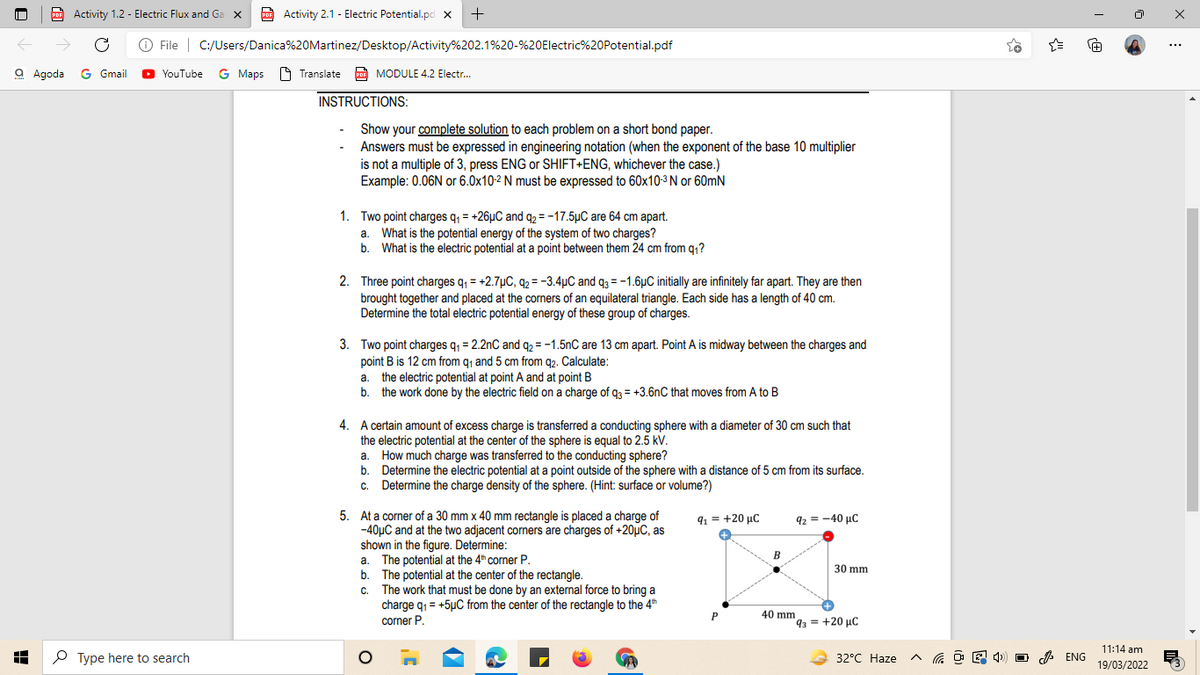2. Three point charges q, = +2.7µC, q2 = -3.4µC and q3 = -1.6µC initially are infinitely far apart. They are then brought together and placed at the corners of an equilateral triangle. Each side has a length of 40 cm. Determine the total electric potential energy of these group of charges.
2. Three point charges q, = +2.7µC, q2 = -3.4µC and q3 = -1.6µC initially are infinitely far apart. They are then brought together and placed at the corners of an equilateral triangle. Each side has a length of 40 cm. Determine the total electric potential energy of these group of charges.
Chapter7: Electric Potential
Section: Chapter Questions
Problem 72P: The practical limit to all electric field in air is about 3.00106 N/C. Above this strength, sparking...
Related questions
Question
M2.1
-answer number 2 only
-complete solution

Transcribed Image Text:POF Activity 1.2 - Electric Flux and Ga x
p Activity 2.1 - Electric Potential.pd x
->
O File | C:/Users/Danica%20Martinez/Desktop/Activity%202.1%20-%20Electric%20Potential.pdf
+1
...
a Agoda G Gmail
YouTube G Maps O Translate
A MODULE 4.2 Electr.
INSTRUCTIONS:
Show your complete solution to each problem on a short bond paper.
Answers must be expressed in engineering notation (when the exponent of the base 10 multiplier
is not a multiple of 3, press ENG or SHIFT+ENG, whichever the case.)
Example: 0.06N or 6.0x10-2 N must be expressed to 60x10-3 N or 60mN
1. Two point charges q, = +26µC and q½ = -17.5µC are 64 cm apart.
What is the potential energy of the system of two charges?
b. What is the electric potential at a point between them 24 cm from q,?
a.
2. Three point charges q, = +2.7µC, 42 = -3.4µC and q3 = -1.6µC initially are infinitely far apart. They are then
brought together and placed at the corners of an equilateral triangle. Each side has a length of 40 cm.
Determine the total electric potential energy of these group of charges.
3. Two point charges q, = 2.2nC and q2 = -1.5nC are 13 cm apart. Point A is midway between the charges and
point B is 12 cm from q1 and 5 cm from q2. Calculate:
a. the electric potential at point A and at point B
b. the work done by the electric field on a charge of q3 = +3.6nC that moves from A to B
4. A certain amount of excess charge is transferred a conducting sphere with a diameter of 30 cm such that
the electric potential at the center of the sphere is equal to 2.5 kV.
How much charge was transferred to the conducting sphere?
b. Determine the electric potential at a point outside of the sphere with a distance of 5 cm from its surface.
Determine the charge density of the sphere. (Hint: surface or volume?)
a.
С.
5. At a corner of a 30 mm x 40 mm rectangle is placed a charge of
-40µC and at the two adjacent corners are charges of +20µC, as
shown in the figure. Determine:
a. The potential at the 4" corner P.
b. The potential at the center of the rectangle.
The work that must be done by an external force to bring a
charge q1 = +5µC from the center of the rectangle to the 4th
corner P.
91 = +20 µC
92 = -40 µC
B
30 mm
C.
40 mm
93 = +20 µC
11:14 am
P Type here to search
32°C Haze
O A ENG
19/03/2022
Expert Solution
This question has been solved!
Explore an expertly crafted, step-by-step solution for a thorough understanding of key concepts.
Step by step
Solved in 2 steps with 1 images

Knowledge Booster
Learn more about
Need a deep-dive on the concept behind this application? Look no further. Learn more about this topic, physics and related others by exploring similar questions and additional content below.Recommended textbooks for you

